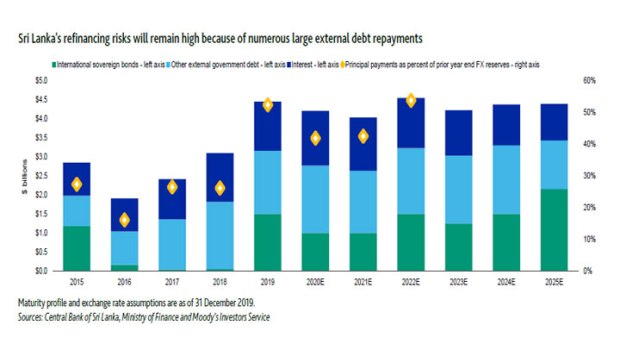Moody’s forecast Sri Lanka 2021 revenues unlikely
Warns bleaker fiscal outlook may hurt $4bn re-financing
COLOMBO – Sri Lanka is unlikely to get targeted revenues in 2021, with activity hit by import controls and worse than expected outlook for fiscal consolidation is likely to make it more difficult to re-finance US$ 4 billion of debt in 2020, Moody’s a rating agency forecast on Monday (23)..
“On the revenue side, the budgeted 28% increase in government revenue compared to 2020, largely stemming from robust growth in taxes on goods and services, and external trade, is unlikely to be achieved,” it said, cautioning that domestic demand was also likely to remain sluggish given the still-subdued business and consumer confidence, and ongoing import restrictions affecting industries such as construction and manufacturing. Economic boost from budget will be limited, it said.
Sri Lanka revenues have fallen from around 14.1% of gross domestic product in 2016 to 9.5% in 2020 amid slow growth and December 2019 value added tax cuts, which the government wants to keep for five years, Moody’s noted..
Sri Lanka was targeting a deficit of 8.8% of gross domestic product for 2021, against controversially adjusted 7.9% deficit for 2020. By 2025 a 4% deficit was forecasted and a 75.5% debt to GDP ratio.
“We forecast a similar gap for 2021, but for the deficit to remain above 8% of GDP through 2023 in light of persistently adverse fiscal dynamics and a slow economic recovery,” the rating agency said, warning that it expected Sri Lanka’s debt burden to increase to around 100% of GDP over 2020-21, above the Caa-rated median of 88% of GDP, and only begin to gradually decline in subsequent years.
Moody’s downgraded Sri Lanka to Caa1 (CCC+ equivalent) in 2020.
If deficit reduction is worse than expected, it may be more difficult to repay debt in 2021, the rating agency said.
“A bleaker outlook for fiscal consolidation is likely to continue to challenge the government’s ability to raise financing for upcoming debt obligations and narrow annual borrowing needs, which in 2021, externally, amount to approximately $4 billion,” it said, cautioning that borrowing needs will stay elevated through 2025, including a large portion of maturing international sovereign bonds .
“Elevated repayment risks will continue to raise pressure on the government’s external and liquidity position as the recovery in major sources of foreign exchange earnings is likely to be slow, keeping the country’s international reserves position thin,” it said.
Other analysts have warned that if there is a recovery and the central bank injects money to keep rates down, forex shortages will make it difficult to repay debt.
In 2020 some of the injected liquidity has been absorbed by foreign debt repayments – a type of reserve appropriation taking place through unsterilized dollar sales to the Treasury.
-economynext.com


